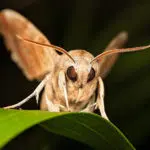The last week in July is all about celebrating the fabulous …. moth! Butterflies’ less-beautiful cousin, moths are nothing to scoff at, and National Moth Week is all about celebrating these delightful (and helpful!) creatures. Did you know moths are among the most diverse organisms on Earth? It’s true! Scientists estimate there are at minimum 150,000 moth species, and some believe that there could be over 500,000! Moths have been found that are small as a pinhead and as large as an adult-human’s hand. But of course, it’s the incredibly complicated wing colors and patterns that make them especially dazzling.
When is National Moth Week 2025?
The last full week of July is celebrated as National Moth Week, from July 17 to July 25 this year.
History of National Moth Week
The beauty of the habitats and life cycles of moths is celebrated during National Moth Week (NMW). Affectionately termed as ‘Moth-ers,’ moth enthusiasts of all ages are encouraged to engage, observe, and document the species of moths in their homes, backyards, and parks. NMW provides everyone with the unique opportunity to appreciate these insects and contribute scientific data as a citizen scientist.
National Moth Week was initiated in 2012 by members of the non-profit organization Friends of the East Brunswick Environmental Commission. Located in Central New Jersey, the organization is dedicated to the conservation and promotion of the local environment. The idea for the week grew out of the popular local moth nights organized by David Moskowitz and Liti Haramaty that attracted novice and experienced moth-ers of all ages. The event quickly evolved into an international citizen science project for which individuals and organizations could sign up and register for events, for free. Participants can take photos and post their observations on dedicated partner websites for data analysis and further study. National Moth Week is set in mid-summer as it is the ideal time for finding moths in the northern hemisphere.
Registered mothing events in the first year of the week-long celebration took place in 49 states and 31 countries worldwide. Today, events are registered in all 50 states and more than 80 countries. Thousands of photos are collected and posted every year, with nearly 100,000 photos on NMW’s Flickr group. The host organization hopes to add another NMW in January for moth-ers living in the southern hemisphere.
National Moth Week timeline
National Moth Week is founded by the Friends of the East Brunswick Environmental Commission, a non-profit organization in New Jersey.
National Moth Week gets featured in “The New York Times.”
420 events are registered for Moth Week in 41 countries.
Despite lockdown restrictions due to the COVID-19 pandemic, the ninth annual National Moth Week attracts hundreds of new participants and breaks several records.
By The Numbers
6 inches – the maximum wingspan of the royal walnut moth.
80 – the number of countries where National Moth Week events are celebrated.
11,000 – the estimated number of species of moths in the U.S. alone.
10 to 1 – the number of moths for each butterfly.
12 inches – the wingspan of the atlas moth, which is considered the largest in the world.
7 miles – the furthest distance from which a male moth can smell a female moth.
90% – the percentage of people in some African countries who eat moths, according to a 2004 survey by the United Nations.
33.7 mph – the speed of one of the world’s fastest flying insects — the hawkmoth.
80% – the percentage of the Lepidoptera order that is made up of moths.
1 year – the life cycle of the giant silkworm moth.
National Moth Week FAQs
When is National Moth Week?
National Moth Week is observed in the last full week of July. In 2021 the dates will be from July 17 to July 25.
What causes moths in the house?
Dark and secure places are what moths gravitate towards. These insects often come into homes through infested food packages. Once inside, they lay eggs that hatch into larvae.
Can moths lay eggs in your hair?
Moths laying eggs in hair is a myth and is scientifically baseless.
National Moth Week Activities
Spare a moth
We've all been guilty of seeing a moth on the wall and reaching for the closest magazine, shoe, or newspaper to smack down the dastardly creature. But for National Moth Week, remind yourself of the wonder of the moth, and how the little buddy on your bedroom wall is living thing! Leave it alone, or use a glass and piece of paper to transfer it safely outside.
Find your spirit moth
You may have heard of a spirit animal, but did you also know that we each have a spirit moth? It's true! Take down your moth guide from the bookshelf or look online through images of moths online (an easy way: go to Google, search moths, and click on the image tab). Find one that speaks to you. That's your spirit moth!
Go mothing
Mothing is easy and also fun. A great activity. Here's how to do it. Hand a white sheet or towel outside and shine a light on it. Put another sheet or towel (any color) on the ground nearby and have a little twilight picnic. As the sun sets, the moths will come, attracted by the fun you're having (just kidding, they're attracted by the light). You're mothing! Count the moths, take selfies with them, pick out your spirit moth. What fun! Shake the towel out when you're done so you can go back to your home moth-free and they can go back to their homes and do whatever moths do.
5 Fun Facts About Moths
More than meets the eye
Moths are among the most diverse and successful organisms on earth.
Vast number of species
Scientists estimate there are 150,000 to more than 500,000 moth species.
Moths are camouflage experts
The dazzling colors and cryptic patterns of a moth help it to camouflage.
Moths are nocturnal
Contrary to its nearest relative, the butterfly, the moth is a night creature.
Special equipment
Serious insect aficionados use bait and special lights to attract moths.
Why We Love National Moth Week
They are great pollinators
Everyone knows bees help keep the circle of life going, but moths do, too! They have long tube-like tongues that are idea for sipping nectar, and their hairy bodies, evolved to keep them warm in flight, are perfect for pickup up pollen grains and moving them around the garden!
They are an important food source
It's a bid morbid, but moths are an important meal for many animals. Lizards, birds, and even some bears eat moths!
They are the Earth's canaries in a coal mine
Canaries in cages were taken to coal mines to give miners a warning if the air had gone bad (the canary would keel over before humans did). In the same way, moths are a good indicator of how the environment is doing! Moth health and numbers can give important signals about the effects of farming practices, pesticides, air pollution, and climate change on the Earth.
National Moth Week dates
| Year | Date | Day |
|---|---|---|
| 2024 | July 20–28 | Saturday–Sunday |
| 2025 | July 19–27 | Saturday–Sunday |















